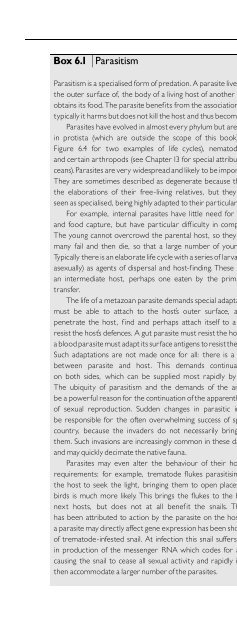An Introduction to the Invertebrates, Second Edition - tiera.ru
An Introduction to the Invertebrates, Second Edition - tiera.ru
An Introduction to the Invertebrates, Second Edition - tiera.ru
You also want an ePaper? Increase the reach of your titles
YUMPU automatically turns print PDFs into web optimized ePapers that Google loves.
PARASITISM71Box 6.1ParasitismParasitismis a specialised form of predation. A parasite livesinside, or attached <strong>to</strong><strong>the</strong> outer surface of, <strong>the</strong> body of a living host of ano<strong>the</strong>r species, from which i<strong>to</strong>btains its food.The parasite benefits from <strong>the</strong> association at <strong>the</strong> host’s expense;typicallyit harms butdoes not kill<strong>the</strong> host and thus become deprived of a home.Parasites have evolved in almost every phylum but are particularly prevalentin protista (which are outside <strong>the</strong> scope of this book), platyhelminths (seeFigure 6.4 for two examples of life cycles), nema<strong>to</strong>des, acanthocephalansand certain arthropods (see Chapter13 for special attributes of parasitic c<strong>ru</strong>staceans).Parasitesare very widespread andlikely <strong>to</strong> beimportantin anyecosystem.They are sometimes described as degenerate because <strong>the</strong>y have lost some of<strong>the</strong> elaborations of <strong>the</strong>ir free-living relatives, but <strong>the</strong>y are more accuratelyseen as specialised, being highly adapted <strong>to</strong> <strong>the</strong>ir particular way of life.For example, internal parasites have little need for organs of locomotionand food capture, but have particular difficulty in completing <strong>the</strong>ir life cycle.The young cannot overcrowd <strong>the</strong> parental host, so <strong>the</strong>y must find new hosts;many fail and <strong>the</strong>n die, so that a large number of young must be produced.Typically <strong>the</strong>reis an elaboratelife cycle with a series of larvae (perhapsmultiplyingasexually) as agents of dispersal and host-finding. These larvae frequently findan intermediate host, perhaps one eaten by <strong>the</strong> primary host, <strong>to</strong> facilitatetransfer.The life of a metazoan parasite demands special adaptations: an ec<strong>to</strong>parasitemust be able <strong>to</strong> attach <strong>to</strong> <strong>the</strong> host’s outer surface, an endoparasite mustpenetrate <strong>the</strong> host, find and perhaps attach itself <strong>to</strong> a particular tissue andresist<strong>the</strong> host’s defences. A gut parasite must resist <strong>the</strong> host’s digestive enzymes,a bloodparasitemust adaptits surface antigens <strong>to</strong>resist<strong>the</strong>host’simmune system.Such adaptations are not made once for all: <strong>the</strong>re is a continuing ‘arms race’between parasite and host. This demands continual individual variationon both sides, which can be supplied most rapidly by sexual reproduction.The ubiquity of parasitism and <strong>the</strong> demands of <strong>the</strong> arms race may indeedbe a powerfulreason for <strong>the</strong> continuation of<strong>the</strong> apparently wasteful proceduresof sexual reproduction. Sudden changes in parasitic infection may in partbe responsible for <strong>the</strong> often overwhelming success of species invading a newcountry, because <strong>the</strong> invaders do not necessarily bring <strong>the</strong>ir parasites with<strong>the</strong>m. Such invasions are increasingly common in <strong>the</strong>se days of rapid transportand may quickly decimate <strong>the</strong> native fauna.Parasites may even alter <strong>the</strong> behaviour of <strong>the</strong>ir hosts <strong>to</strong> suit <strong>the</strong>ir ownrequirements: for example, trema<strong>to</strong>de flukes parasitising certain snails cause<strong>the</strong> host <strong>to</strong> seek <strong>the</strong> light, bringing <strong>the</strong>m <strong>to</strong> open places where predation bybirds is much more likely. This brings <strong>the</strong> flukes <strong>to</strong> <strong>the</strong> birds, which are <strong>the</strong>irnext hosts, but does not at all benefit <strong>the</strong> snails. This behaviour changehas been attributed <strong>to</strong> action by <strong>the</strong> parasite on <strong>the</strong> host hormones, but thata parasite may directly affect gene expression has been shown in ano<strong>the</strong>r speciesof trema<strong>to</strong>de-infested snail. At infection this snail suffers a three-fold increasein production of <strong>the</strong> messenger RNA which codes for a brain neuropeptide,causing <strong>the</strong> snail <strong>to</strong> cease all sexual activity and rapidly increase in size: it can<strong>the</strong>n accommodate a larger number of<strong>the</strong> parasites.











